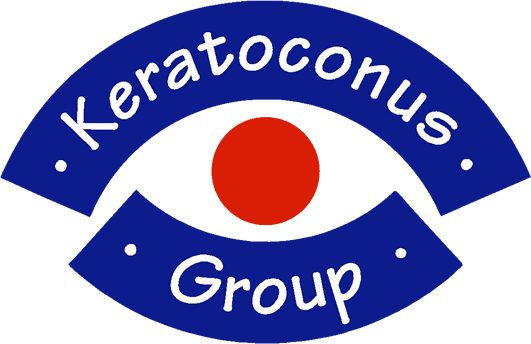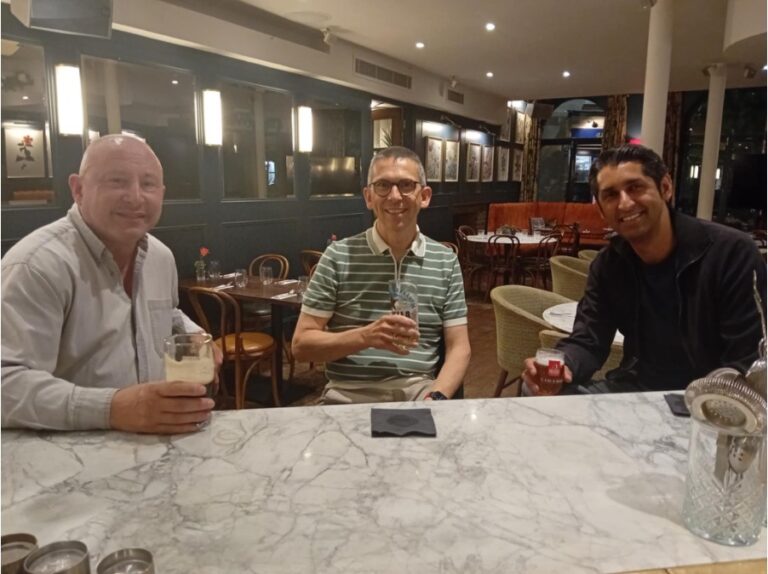By Peter Field
HERTFORD UK, APRIL / MAY 2025 at The BEAM theatre complex
There is something quite magical when you arrive at Hertford on a warm, sunny, sky blue spring day. With it’s well preserved Georgian buildings and picturesque views from bridges across the River Lea It’s almost as if time has stood still with present realities only being given away that we are already a quarter of away into the 21st century by the odd passing by of a Tesla car.
Thank goodness some things hardly change, including Ken Pullum’s passion and commitment to scleral lenses and the holding of the twice annual Specialist Keratoconus Symposium, subject matter being on the management of keratoconus with scleral lenses. This year’s event was held at the recently renovated Beam theatre with previous events also being held at the 15th century Hertford Castle and The Salisbury hotel dating back from 1413 which was also known as The Bell.
The three days were dedicated to all aspects of specialist management of clinically and visually indicated of contact lens gave to various contact lens practitioners about various scenarios involving the management of keratoconus with various contact lenses.
Day 1 concentrated on the application of corneal RGP lenses which are sadly not extensively covered by universities these days. Ken Pullum, principal optometrist, scleral lens service, Moorfields Eye Hospital, started the ball rolling in three presentations, illustrating the impact on the clinical appearance that could be expected by changing the contact lens parameters. The first taking RGP corneal lens fitting from first principles, distinguishing between flat and steep central optic fitting, especially focussing what constitutes a clinically significant difference. While Ken’ style is more based on the visual appearance of lenses in situ rather than the use of topography to select initial parameters, he did show how topography can be used to explain the appearance. The second looked at the peripheral design, and how to interpret and predict axial edge lift and how this relates to functional corneal RGP lens fitting. The third particularly addressed the challenge of keratoconus with RGP corneal lenses. He discussed the target of three point touch, but more importantly, how there can be many variants, not all optimal!, the end points in fitting process, how to reach them with various contact lens fitting systems and perhaps surprisingly, the possible latitude.
Claus Van Weezel, was a guest speaker visiting from Denmark, from time to time contributing to earlier meetings over the last 25 years. He took RGP corneal lens practice to another level, describing use of topography to construct complex designs, toroidals, quadrant specific and de-centred optics.
Ken and Keith Williams, contact lens optician from Abergele, north Wales, briefly introduced the notion of hydrogel lenses in the management of keratoconus, particularly drawing attention to their under-rated application. Is a hybrid a soft lens or a corneal? Shreeti Lakhani, principal optometrist, Contact Lens Service, Moorfields, provided the answer …. they have the potential to give the visual correction of a corneal RGP but with the comfort and stability of a hydrogel. She covered the range of lenses available, and explained how SynergEyes are trying to encourage a move away from extensive fitting sets to application of topography to establish optimum parameters.
Vijay Anand, principal and head of optometry at Moorfields, covered the challenging subject of post surgical contact lens clinical methods. There is no doubt that this is a complex area, with completely different considerations compared to keratoconus prior to corneal transplantation. Typically, as Vijay pointed out, we’d be looking at a characteristic oblate corneal topography, using examples of RGPs, hydrogels and sclerals. He emphasised the need for special attention to the physiological requirements post surgery, for example the possibility of contact lens induced hypoxia because of the increased chance of a compromised endothelium.
Ken returned to the platform describing how the ageing process in the keratoconus group is only just recently beginning to resemble a normal demography. His explanation for this was that in the late 1970s and early 1980s, a person with keratoconus aged over 30 years presenting at clinics was something of a rarity. Where did they go? It looks like they just gave up, not relishing the prospect of taking up the treatment options on offer. However, from the mid 1980s, the norm became the opposite, and it became necessary to offer a better follow up service. Now in the 2020s, the then 30 year olds are now 70, and approaching the need for normal age related cataract extraction. Since preliminary biometry procedures are notoriously inaccurate in keratoconus, there is a certain amount of guesswork in the selection of the power required for an IOL. Ken outlined how noting the functional contact lens power formula can be utilised to assist with the calculations.
Day 2 focused on keratoconus management other than use of corneal RGP lenses. Aneel Suri, principal optometrist, Moorfields, set the day in motion describing the application of hydrogels and silicone hydrogels including how “piggy backing” with a soft lens cushion. There are many hydrogel options recently developed, and many provide a working alternative to rigid lenses. The improved comfort is a major benefit for people dependent on contact lenses for functional vision even if the vision may be inferior. However, as Aneel pointed out, in some instances, with recent developments, the vision is not necessarily worse than with RGP corneals. He went on to inform the meeting that there is more to piggy backing than simply to open a -0.25 daily disposable. Use of alternative powered soft lenses can alter the anterior surface, either positive or negative to give a steeper or flatter surface respectively. Quadrant specific soft lens designs may also help improved alignment under some circumstances.
Ken introduced the subject of “beyond the limbus, too large for corneal, but too small for a scleral”. A complicated fitting process as the appearance may resemble a large corneal or a mini scleral with a very narrow annular bearing surface, both with quite different fitting characteristics, and with an element of unpredictability. He touched upon the various properties of the lens sets use at Moorfields, and other clinical establishments, including the B&L Zen Lens, the Optosoft IS16 and IS19 mini scleral lens range, and the Jack Allen PVS range. Keith presented an excellent account of the fitting process, comparing the 14mm (P14, JACL) range and the ClearView (Acuity CL) designs.
Nick Howard assisted by Tazeem Hussain, representing Bausch and Lomb, gave a lively comprehensive account of their 48 lens Zen Lens fitting set, with 16mm and 17mm, diameters, oblate and prolate designs and torics including bi-elevationals. Notching and microvaulting are additional option available when appropriate. He pointed out that in the majority of cases, a sizeable majority are adequately dealt with using just 6 or 7 lenses!! Aneel added to the discussion with a selection of case studies in his presentation using topographical devises and corneo-scleral profiling to design scleral lens parameters. He described how the practitioner can be involved in the design process, or if preferred, can defer this to the supplier.
Ken finished the day with an account of the pros and cons of full diameter sclerals, describing how they can be chosen to circumvent some of the problems we encounter from time to time with mini sclerals, such as indentation and rebound hyperaemia. He pointed out that the end point of the fitting process is reached in a straightforward manner, how forgiving is the scleral zone fitting and the prospect of a long term stable result. The final topic of the day was to introduce eye impression sclerals, emphasising that it has been around for many decades. Although falling out of regular use for a long time, impressions have enjoyed something of a revival recently as the technique has been revolutionised to encompass RGP materials for scleral lenses.
A concentrated two days was rounded off socially with an enjoyable meal at a local restaurant, revitalising the delegates for the final instalment!!
In the morning of the final day, Ken covered therapeutic applications of sclerals, management of ocular surface disorders and the use of sclerals to address ptosis, either with a shelf or simply with extra thick substance. Complications of scleral lenses were covered with each subject during the course of the three days, but summarised with the comment that complications need to be kept in perspective given the massive improvement in quality of life achieved under circumstances when they are needed most. Yetunde Obadeyi, principal optometrist, contact lens service at Moorfields, finished the clinical presentations with a selection of case studies, including a paediatric visually rehabilitated with scleral lenses.
How do you teach the process of teaching scleral lens handling? Tracy Partridge, practice manager at Hertford Optometry and mainstay in the lens handling department, enlightened the group on salient point necessary to make sure new wearers are competent …. you don’t achieve anything with the best possible CL fitting if the handling skills are not inadequately mastered!! Gareth Ashman, journalist and 30 years and counting scleral lens wearer, regaled the group with his roller coaster account of life with sclerals ….. living a normal life, skiing, riding motor cycles, keeping off butthe operating table for nearly two decades, the recurrent hydrops, but generally coping. All with the help of scleral lenses, even though finally needing a transplant, and the continued ups and downs following that … it didn’t end on the day of the surgery!
The afternoon was dedicated to a practical session. Everyone applied and removed a scleral lens, sometimes with a small amount of gentle persuasion, and took their first eye impressions. Yetunde conducted a demonstration of full diameter scleral lens fitting, while Nick and Taz took on a live Zen Lens fitting using the equipment kindly provided by Hansen Instruments, Reddich, Worcs.
Peter Field
Formerly production manager, Bausch and Lomb, Hastings, and currently representative of The Keratoconus UK self help group
Testimony:
I took a great deal from Ken’s 3-day Contact Lens Symposium – particularly the opportunity to meet and learn from so many experienced, passionate professionals in the field.
My favourite part was the hands-on session: taking an impression of the eye and fitting large-diameter scleral lenses. At 23mm, it looked huge! I remember thinking, “How am I going to fit this in the eye?”
Overall, it was an amazing and inspiring experience that has really deepened my understanding of speciality contact lens work, and I look forward to bringing these new skills back to my contact lens clinics in the hospital.
– Habeeb Rahman,
Hospital and Independent Pre-registration Optomterist









